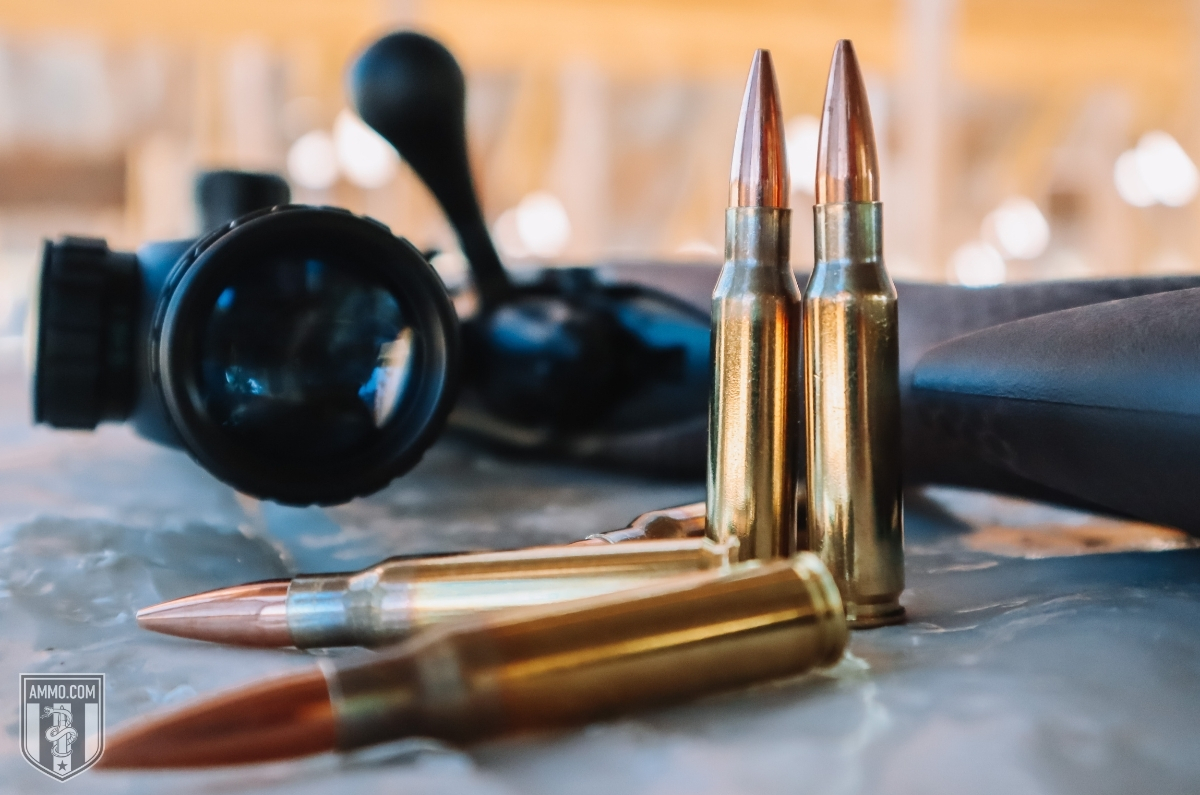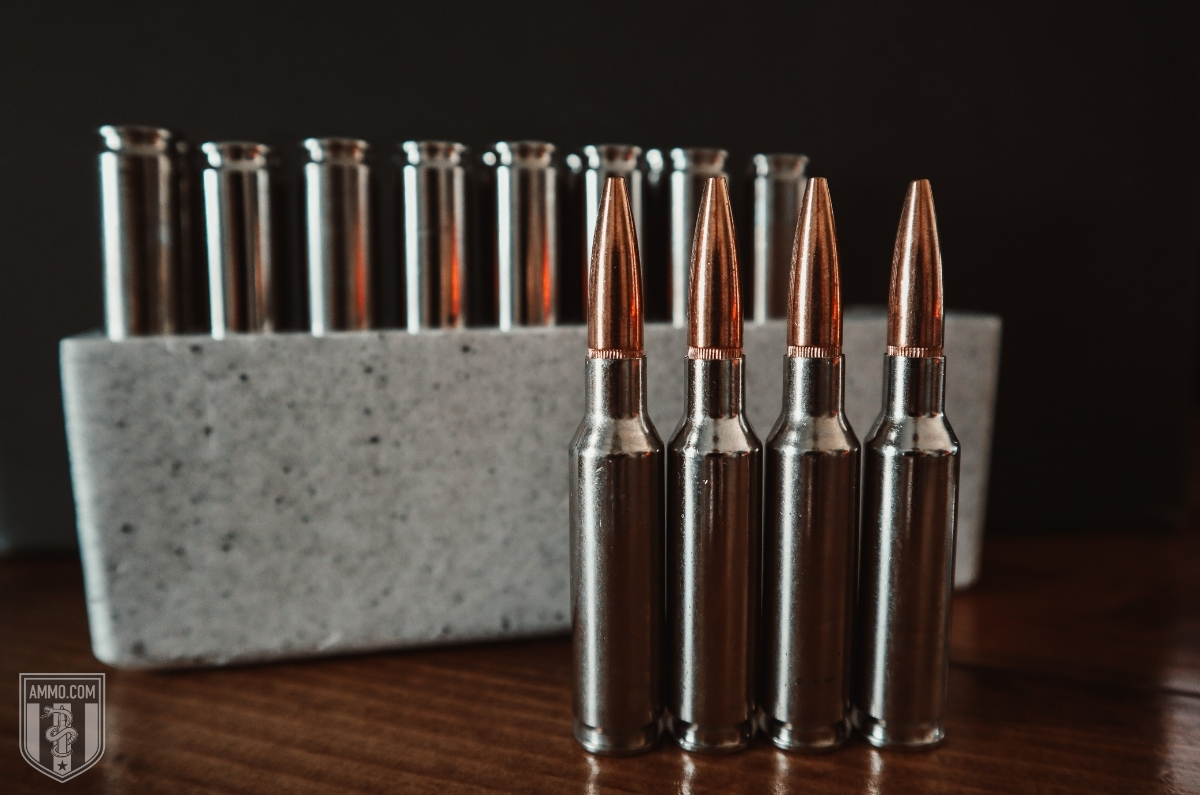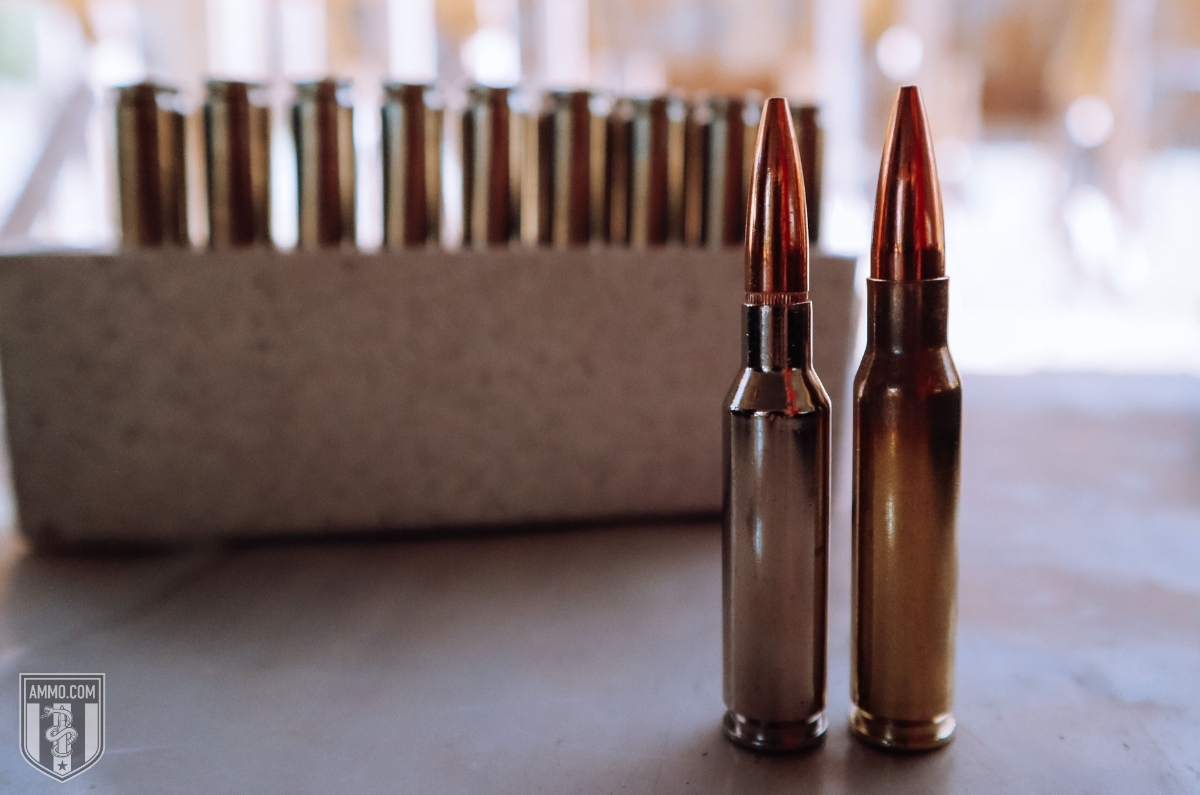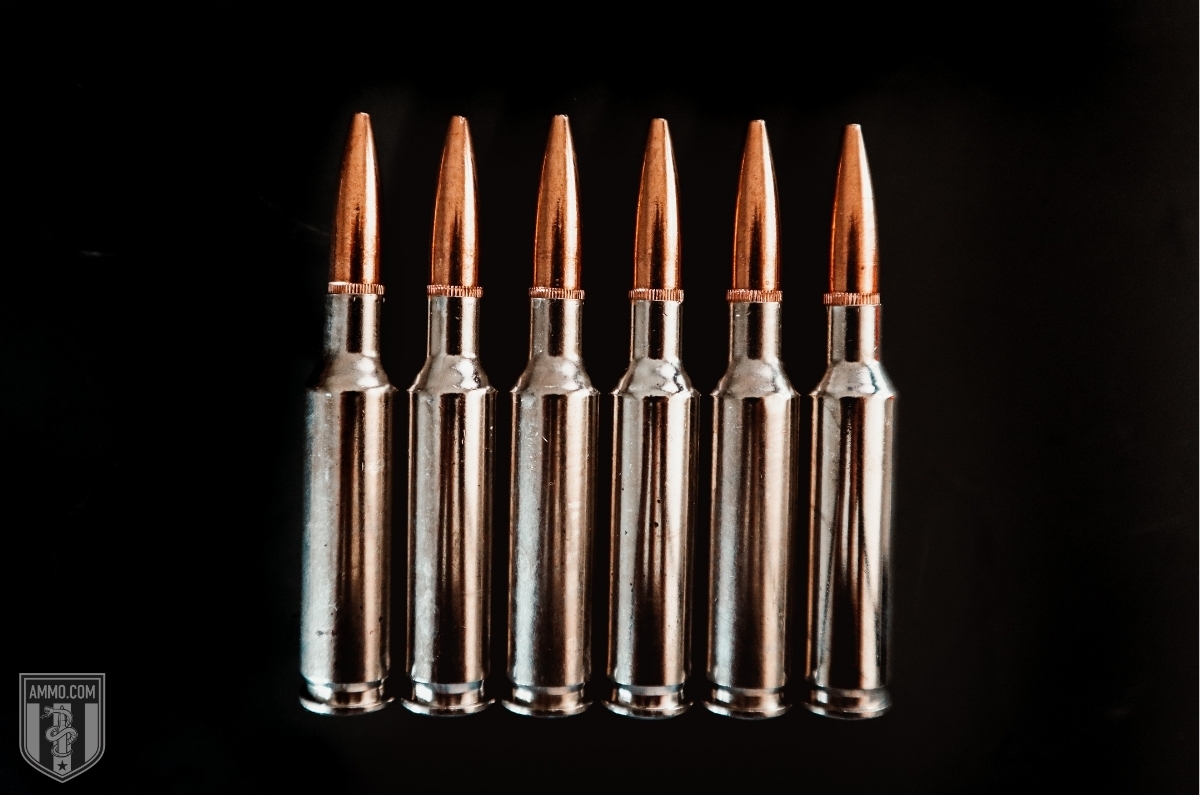6.5 Creedmoor vs 308 Winchester: A Battle of Ballistic Coefficients
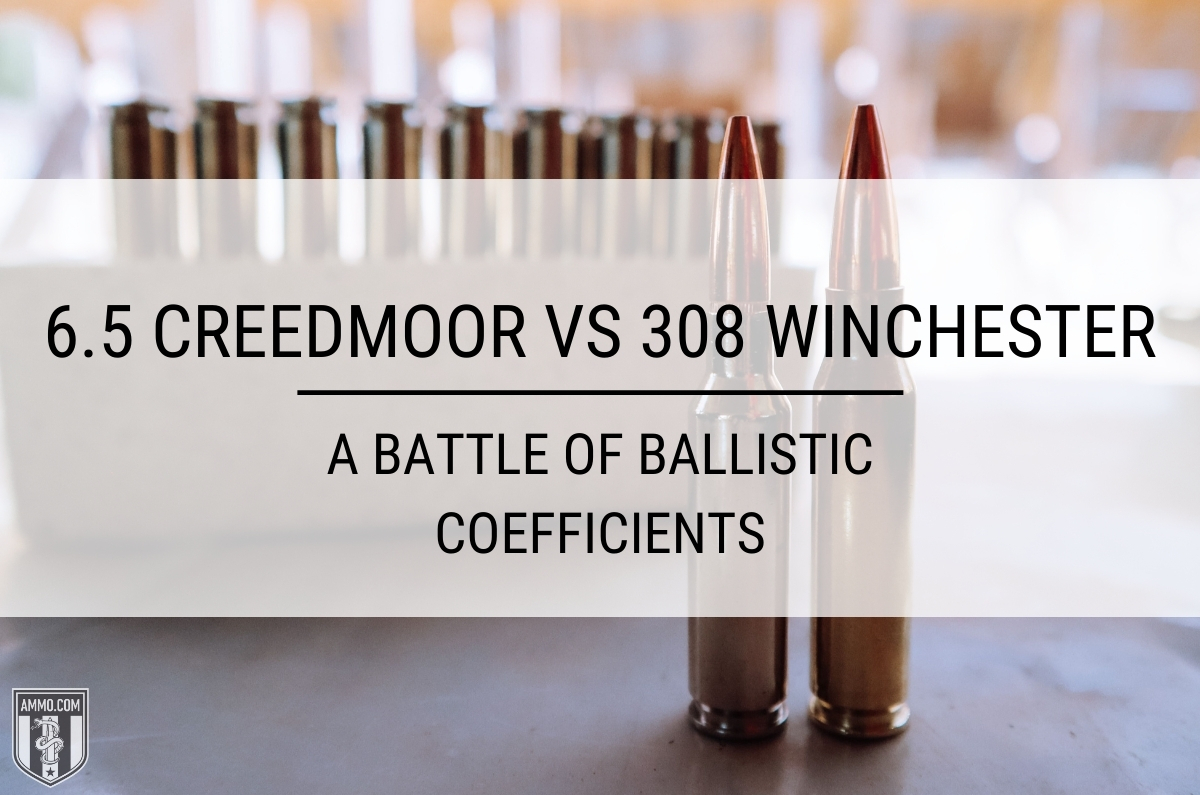
When it comes to long range shooting, two calibers that cannot be ignored are the 6.5 Creedmoor and the venerable 308 Winchester.
Although the 308 Winchester (7.62 NATO) has been a staple in the long-range target shooting community since its inception over 60 years ago, the 6.5 Creedmoor simply outperforms the 308 Winchester in almost every category when shooting out past 500 yards.
In this article, we are going to go through a detailed comparison of 308 vs 6.5 Creedmoor and explain the pros and cons of each cartridge, as well as discuss the ballistics data for these two popular calibers.
Break out your sandbags, bipods, and spotting scopes because we are going to squeeze the trigger and let it fly on long range shooting today!
What is 308?
In 1952, the U.S. Military started developing a replacement for the long-serving 30-06 Springfield cartridge (military designation: M2 Ball or 7.62x63mm).
Although the 30-06 Springfield had honorably served through both World Wars and Korea, the US Military wanted to develop a new cartridge that was lighter and more suitable for fully automatic rifle fire.
With advancements in rifle powder technology and case design in the 1950s, the new 7.62x51mm NATO rifle round was able to achieve neatly identical ballistic performance as the 30-06 Springfield with a shorter cartridge case length (63mm vs 51mm) and lower overall weight.
The US Army officially adopted the 7.62x51mm NATO round in 1958 and it has been in service ever since.
Seeing the potential of the cartridge in the civilian market, Winchester was quick to adapt the new rifle round to its Model 70 bolt action rifle. The civilian version of the 7.62x51mm NATO was named the 308 Winchester.
The 308 Winchester has since become the most popular big game hunting round in the world with bullet weights ranging between 120 to 180 grains.
308 ammo is available in a variety of loadings for varmint hunters, big game hunters, and F-Class Tactical Rifle shooters alike.
As the 308 Winchester was also adopted by other NATO nations, the amount of surplus ammo and components made by foreign manufacturers is also very plentiful.
The 308 Winchester is a clear upgrade to the 30-06 Springfield as the 308 has lower recoil, the round itself weighs less, it fits in a short action rifle, has lower pressure so it is more appropriate for use in gas powered rifles, and it has a slight advantage in accuracy over its older counterpart.
With all of these advantages, the 308 Winchester has been a staple for precision shooters in the military, law enforcement, and civilian life.
Although the 308 Winchester is the most prolific military cartridge to date, its true success came in the civilian market.
Hunters and target shooters are mostly to credit for the 308’s widespread success.
The most popular hunting ammo is sold with a 125, 150, 165, or 180 grain bullet and can be used effectively on big game across North America, Europe, and on safari in Africa. Of these rifle cartridges, the 150’s and 165’s are the most popular and will have a muzzle velocity around 2800 fps and 2650 fps, respectively.
For my readers who like to really air it out and enjoy long range shooting, the two most popular choices are the 168 and 175 grain bullet: either a Sierra Matchking Boattail Hollow Point or a Berger VLD Target.
However, what long-range target shooters have come to understand is that a slower, heavier bullet with a higher Ballistic Coefficient (BC) is preferred to a lighter bullet with a higher muzzle velocity when you are getting into longer ranges (800+ yards).
This is where the 6.5 Creedmoor comes into the picture.
What is 6.5 Creedmoor?
The development of the 6.5 Creedmoor round began in August of 2005 during Service Rifle Week at the National Matches in Camp Perry, Ohio.
As with most innovations, the genesis of the 6.5 Creedmoor came out of frustration – and that frustration came from legendary Service Rifle competitor and former US Marine, Dennis DeMille.
Several of the competitors at the National Matches were using a wildcat cartridge called the 6XC. Although the 6XC was winning matches, there was no published reloading data for the cartridge and it was consistently blowing out primers and breaking extractors (clearly they never called me about this problem!)
DeMille was working for the company that was the exclusive distributor of rifles chambered in 6XC, and competitors would come to him between strings of fire to ask for help (AKA complain).
DeMille had just about had enough of it and was about to throw in the towel and head home. Thankfully, he was sharing a condo with a good friend of his and soon the gripe session began.
That friend was none other than Dave Emary, the senior ballistician for Hornady Ammunition at the time.
Emary was able to talk DeMille off the ledge and asked him to give him a “wishlist” for the ideal long-range cartridge that could be used for “shooting across the course” (that’s High Power-speak for being viable for all the courses of fire in a High Power match.)
DeMille agreed and the next day he approached Emary with a list of 7 requirements for the new cartridge.
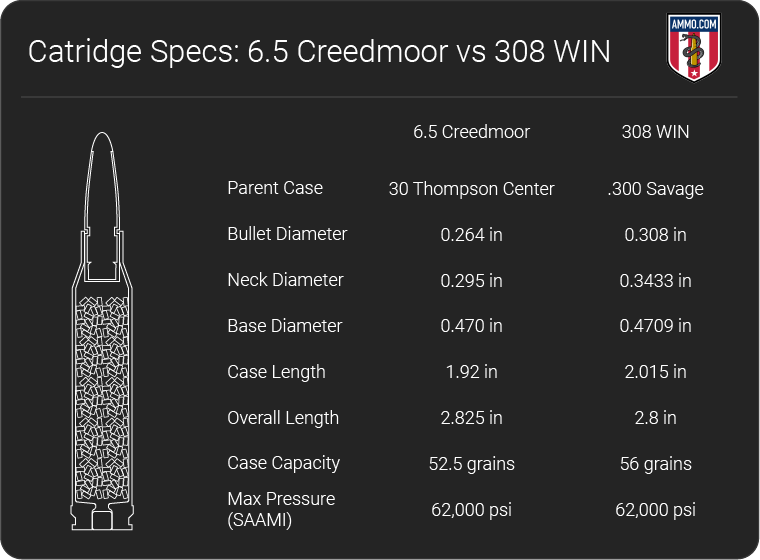
DeMille’s Dream Cartridge Wishlist Was:
- The cartridge must be able to fit into a magazine for the rapid fire stages of the competition
- Less recoil than a 308 Winchester for better follow-up shots and shooter comfort during rapid fire
- Flatter trajectory than a 308 with an accurate, high BC bullet
- Good barrel life
- Uses readily available reloading components so results can be duplicated
- Reloading recipes printed on the box
- Produced in quantities that could keep up with demand
Emary took DeMille’s list back to Hornady and got to work on producing the ideal long range rifle cartridge.
Emary chose the relatively unknown 30 Thompson Center (30 T/C) as the parent cartridge for the 6.5 Creedmoor. He necked down the case to accept the more aerodynamic .264” diameter bullets and sharpened the shoulders to 30 degrees and the 6.5 Creedmoor was born.
Emary initially wanted to call the new round the 6.5 DeMille but DeMille would hear nothing of that. Instead, DeMille recommend the name “Creedmoor” in honor of the Creedmoor Rifle Range in Long Island, New York where the first National Matches were held.
And so, in 2007, Hornady unveiled their new 6.5 Creedmoor ammo at SHOT Show in Las Vegas, Nevada.
They didn’t have high hopes for this new cartridge and had no idea that the Hornady 6.5 Creedmoor ammo was about to take the long range shooting scene by storm.
The 6.5 Creedmoor is loaded in a variety of bullet weights that are typically separated into two categories. The Light Weight category, which ranges from 127 to 135 grain bullet weights, and the Heavy Weight category, which is loaded with 140 to 147 grain bullets.
The cartridge rim of the 6.5 Creedmoor is identical to the 308 Winchester, which means all that is needed to convert a precision rifle or semi-automatic rifle chambered in 308 Winchester to 6.5 Creedmoor is a barrel change. No need to buy a new rifle!
308 vs 6.5 Creedmoor: Which is Better?
Now that you have a better idea about the history of both cartridges, it’s time we take an objective look at both of these long-range target shooting titans and see who comes out on top!
Recoil
When it comes to recoil, the less you have the more accurate you will shoot. Therefore, less is better.
When you are shooting long matches or just out on the range for an extended period of time, shoulder wear is a real problem. The less your rifle pounds on your shoulder, the less you will jerk the trigger during firing (this is called “recoil anticipation").
In terms of recoil, there is no contest as 6.5 Creedmoor has about 30% less felt recoil than 308 Winchester.
Winner: 6.5 Creedmoor by a country mile
Barrel Life
For all of my readers who are hunters, it’s unlikely that you will ever “shoot out” a barrel to the point where accuracy suffers. However, for competitive shooters or long-range target shooters using a high precision rifle, this is a real problem. Barrel wear typically begins at the throat of the chamber, where the bullet enters the barrel.
This is one of the few shortfalls of the 6.5 Creedmoor, as a match grade Creedmoor barrel will typically only last about 2000 rounds whereas a 308 match barrel will hold true for around 5000 rounds. This is primarily due to similar case capacity for both cartridges.
The specifications for 6.5 Creedmoor and 308 Winchester state the case capacity at 52.5 gr and 53.5 gr, respectively. This means that the powder charge for both cartridges will be similar. This large of a powder charge in a smaller diameter barrel will mean that the 6.5 Creedmoor will wear out a barrel considerably faster.
Winner: 308 Winchester hands down
Hunting
On paper, you would think that the 308 Winchester would be the clear winner in terms of hunting efficacy. The .30” bullet “should” leave a larger wound channel, causing more blood loss and deeper penetration.
However, in the field, this is not necessarily the case.
The simple truth is that you will not see any appreciable difference in wound channels between the 6.5 and the 308. Both the 308 Winchester and the 6.5 Creedmoor have enough kinetic energy to take down large game from whitetail deer all the way to bull elk without issue. That being said, the 308 Winchester does offer more varieties of ammo, including offerings with heavier bullets up to 180 grains to take on dangerous game, like black bear, without issue. At closer ranges below 500 yards, the 308 Winchester has more kinetic energy (ft/lbs) than the 6.5 Creedmoor. However, I’m pretty sure the deer in your crosshairs is not going to be able to tell the sub-10% difference between the two rifle cartridges.
One important thing to consider for both the 308 and 6.5 Creedmoor is hunting ammo availability. Although originally developed for competitive shooting, hunting loads like Federal Premium 6.5 Creedmoor have become commonplace on gun store shelves and in sporting goods stores across the nation. The 308 will generally have more hunting ammo varieties available, but 6.5 Creedmoor is getting more popular by the day and is catching up at an alarming rate.
Another consideration when picking a round for hunting is Sectional Density (SD). Sectional Density is the ratio of bullet diameter compared to its mass. It goes without saying, that heavier bullets in any caliber are going to be longer than lighter bullets in the same caliber. This means that heavier bullets will have a higher SD and therefore penetrate deeper than their lighter counterparts.
Make sure you are fully stocked with Hornady 6.5 Creedmoor hunting ammo for this fall and that you bring home that trophy buck that you have always wanted!
308 Winchester hunting rounds typically go up to a maximum of 180 grains in bullet weight. Your typical 180 grain 308 ammo will have a sectional density of 0.253 while a 6.5 mm 140 grain bullet will have a sectional density of 0.287.
With less recoil, lower wind drift, lower bullet drop rates, higher sectional density, and a flatter trajectory make the 6.5 Creedmoor the ideal hunting round for your new rifle next season.
Winner: 6.5 Creedmoor
Accuracy
There’s no doubt that the 308 and the 6.5 Creedmoor are extremely accurate rounds. Match grade loadings with Sierra Matchkings, Hornady ELD-X, or Berger VLD Target bullets will give you sub-MOA (Minute of Angle, 1 MOA = 1" at 100 yards) accuracy if you do your part.
However, with lower recoil, the 6.5 Creedmoor will give most shooters better accuracy results out of the box with 1/2 MOA and 3/4 MOA groupings being easily attainable.
Winner: 6.5 Creedmoor by a slight margin
Long Range Performance (800+ yards)
There’s no doubt that both rounds are capable of doing very well at long range. Military, LE, and civilian shooters have been using 308 at longer ranges for decades; however, everyone seems to be running to the 6.5 Creedmoor and there’s a reason for that! When it comes to longer ranges, the 6.5 Creedmoor was specifically designed to outperform the 308, and it does so in spades.
Looking at the ballistics data tables below, you can clearly see that the 6.5 Creedmoor outperforms the 308 Winchester in every category past 500 yards. 175 gr 308 Winchester loadings are typically coming close to the edge of being transonic at 1000 yards, while the 6.5 Creedmoor is still well above the supersonic FPS that is needed to maintain accuracy at that range.
It’s clear that the 6.5 Creedmoor is the ideal ammo for shooting longer ranges, hands down.
Winner: 6.5 Creedmoor
Reloading
Reloading components for both calibers are readily available and easy to find. Furthermore, there are no “tricks” to learn when handloading a 6.5 mm cartridge compared to a 30 caliber. Both the 308 Winchester and the 6.5 Creedmoor are a dream to load with a plethora of bullet and powder options to choose from to dial in your ideal handload for your favorite long distance rifle.
Bottom line is that both rifle cartridges are a joy to reload.
Winner: Draw
Military and LE Application
In October of 2017, US Special Operations Command (USSOCOM) tested the performance of the long-serving 7.62x51mm NATO against the 260 Remington and the 6.5 Creedmoor and the results are astounding to say the least! It was determined that military snipers using the 6.5 Creedmoor had DOUBLE the hit probability at 1000 meters.
Furthermore, they ascertained that the 6.5 Creedmoor:
- Increased their shooters’ effective range by approximately 33%
- Experienced 40% less wind drift
- Had 30% less recoil
- Delivered approximately 50% more kinetic energy to the target
Those numbers are staggering to say the least and Uncle Sam took notice and began converting their MK110A1 and Mk20 precision rifles to 6.5 Creedmoor in 2019. As we discussed earlier, all that was required was a barrel change as the Creedmoor was designed to fit in the magazine and on the bolt face for a 308 Winchester.
The 7.62x51mm NATO has served our military valiantly for well over 60 years and it will continue to do so in other firearms such as the M240B and the FN-SCAR. However, when it comes to long range precision shooting, the 6.5 Creedmoor is clear winner.
Winner: 6.5 Creedmoor
Ballistics Comparison: 308 vs 6.5 Creedmoor
The proof is in the numbers and there’s no doubt that you’ll see the differences between the 308 vs 6.5 Creedmoor in these popular loadings in the ballistics tables below.
6.5 Creedmoor Ballistics
Note: This information comes from the manufacturer and is for informational purposes only. The actual ballistics obtained with your firearm can vary considerably from the advertised ballistics. Also, ballistics can vary from lot to lot with the same brand and type load.
| 6.5mm Creedmoor Bullet WEIGHT | Muzzle VELOCITY (fps) | Muzzle ENERGY (ft. lbs.) | TRAJECTORY (in.) | |||||||||||
|---|---|---|---|---|---|---|---|---|---|---|---|---|---|---|
| Muzzle | 100 yds. | 200 yds. | 300 yds. | 400 yds. | Muzzle | 100 yds. | 200 yds. | 300 yds. | 400 yds. | 100 yds. | 200 yds. | 300 yds. | 400 yds. | |
| 120 Grain | 3020 | 2815 | 2619 | 2430 | 2251 | 2430 | 2111 | 1827 | 1574 | 1350 | 1.4 | 0 | -6.5 | -18.9 |
| 120 Grain | 3050 | 2850 | 2659 | 2476 | 2300 | 2479 | 2164 | 1884 | 1634 | 1310 | 1.4 | 0 | -6.3 | -18.3 |
| 129 Grain Superformance | 2950 | 2756 | 2570 | 2392 | 2221 | 2492 | 2175 | 1892 | 1639 | 1417 | 1.5 | 0 | -6.8 | -19.7 |
| 140 Grain | 2550 | 2380 | 2217 | 2060 | 1910 | 2021 | 1761 | 1527 | 1319 | 1134 | 2.3 | 0 | -9.4 | -27 |
| 140 Grain | 2710 | 2557 | 2410 | 2267 | 2129 | 2283 | 2033 | 1805 | 1598 | 1410 | 1.9 | 0 | -7.9 | -22.6 |
| 140 Grain | 2820 | 2654 | 2494 | 2339 | 2190 | 2472 | 2179 | 1915 | 1679 | 1467 | 1.7 | 0 | -7.2 | -20.6 |
308 Ballistics
Note: This information comes from the manufacturer and is for informational purposes only. The actual ballistics obtained with your firearm can vary considerably from the advertised ballistics. Also, ballistics can vary from lot to lot with the same brand and type load.
| 308 Winchester Bullet WEIGHT | Muzzle VELOCITY (fps) | Muzzle ENERGY (ft. lbs.) | TRAJECTORY (in.) | |||||||||||
|---|---|---|---|---|---|---|---|---|---|---|---|---|---|---|
| Muzzle | 100 yds. | 200 yds. | 300 yds. | 400 yds. | Muzzle | 100 yds. | 200 yds. | 300 yds. | 400 yds. | 100 yds. | 200 yds. | 300 yds. | 400 yds. | |
| 55 Grain | 3770 | 3215 | 2726 | 2286 | 1888 | 1735 | 1262 | 907 | 638 | 435 | -2 | 1.4 | -3.8 | -15.8 |
| 110 Grain | 3165 | 2830 | 2520 | 2230 | 1960 | 2447 | 1956 | 1551 | 1215 | 938 | 1.4 | 0 | -6.9 | -20.9 |
| 120 Grain | 2850 | 2497 | 2171 | n/a | n/a | 2164 | 1662 | 1256 | n/a | n/a | 0 | -2.8 | n/a | n/a |
| 150 Grain | 2820 | 2533 | 2263 | 2009 | 1774 | 2648 | 2137 | 1705 | 1344 | 1048 | 2.5 | 0.4 | -8.5 | -26.1 |
| 150 Grain Superformance | 3000 | 2772 | 2555 | 2348 | 1962 | 2997 | 2558 | 2173 | 1836 | 1540 | 1.5 | 0 | -6.9 | -20 |
| 155 Grain | 2775 | 2553 | 2342 | 2141 | 1950 | 2650 | 2243 | 1887 | 1577 | 1308 | 1.9 | 0 | -8.3 | -24.2 |
| 155 Grain | 2850 | 2640 | 2438 | 2247 | 2064 | 2795 | 2398 | 2047 | 1737 | 1466 | 1.8 | 0 | -7.5 | -22.1 |
| 165 Grain | 2700 | 2440 | 2194 | 1963 | 1748 | 2670 | 2180 | 1763 | 1411 | 1199 | 2.5 | 0 | -9.7 | -28.5 |
| 168 Grain | 2680 | 2493 | 2314 | 2143 | 1979 | 2678 | 2318 | 1998 | 1713 | 1460 | 2.5 | 0 | -8.9 | -25.3 |
| 168 Grain Super Match | 2870 | 2647 | 2462 | 2284 | 2114 | 3008 | 2613 | 2261 | 1946 | 1667 | 1.7 | 0 | -7.5 | -21.6 |
| 170 Grain | 2000 | 1740 | 1510 | n/a | n/a | 1510 | 1145 | 860 | n/a | n/a | 0 | 0 | 0 | 0 |
| 178 Grain | 2620 | 2415 | 2220 | 2034 | 1857 | 2713 | 2306 | 1948 | 1635 | 1363 | 2.5 | 0 | -9.6 | -27.6 |
| 178 Grain Super Match | 2780 | 2609 | 2444 | 2285 | 2132 | 3054 | 2690 | 2361 | 2064 | 1797 | 1.8 | 0 | -7.6 | -21.9 |
| 180 Grain | 2620 | 2393 | 2178 | 1974 | 1782 | 2743 | 2288 | 1896 | 1557 | 1269 | 2.5 | -0.2 | -10.2 | -28.5 |
The 308 vs 6.5 Creedmoor Champion is Crowned
There’s no denying that the 6.5 Creedmoor is a superior cartridge when compared to the 308 Winchester.
But does that mean you need to sell all your 308 rifles and load up on 6.5s? Not in the slightest!
The 308 Winchester is going to serve most shooters’ needs without issue and it is a tried and tested design that will not fail you when the moment arises.
Buying in bulk is always smart, make sure to check out our stock of bulk 308 ammo.
However, if you are interested in getting into long-range target shooting, F Class Tactical Rifle, or shoot in the National Matches, then you need to give serious consideration on upgrading to 6.5 Creedmoor.
Simply put, the 308 Winchester is an older design, and the 6.5 Creedmoor is a straight upgrade similar to the 30-06 Springfield to 308 Winchester transition in the 1950s.
With similar muzzle velocity, a flatter trajectory similar to a 300 Win Mag, a longer effective range, lower wind drift and bullet drop, higher ballistic coefficient, and less recoil, the 6.5 Creedmoor is clearly the superior round.
With its superior Sectional Density, the 6.5 Creedmoor can ethically harvest any large game animal just as effectively as the 308 Winchester and is an excellent choice for your next hunting rifle.
Both rifle cartridges will serve you well, but if you’re in the market for a new short action rifle from Savage, Remington, or Ruger, and you’re looking to do some precision shooting, then you need to give the 6.5 Creedmoor a serious look. You are NOT going to be disappointed in the sub-MOA results you see downrange. (Your shoulder will thank me later!)
Ammo Comparisons
- .308 vs 5.56
- 6.5 Creedmoor vs .308
- .300 Blackout vs .308
- .300 Win Mag vs .308
- .243 vs .308
- .308 vs .30-06
- 7mm-08 vs .308
- .270 vs .308
- 7.62x39 vs .308
- .223 vs .308
- .338 Lapua vs .308
- .380 ACP vs 9mm
- .223 vs 5.56
- .300 Blackout vs 5.56
- 9mm vs 45 ACP
- 9mm vs 40 S&W
- .357 SIG vs 9mm
- 10mm vs 9mm
- 9mm vs 9mm Luger
- .243 vs .270
- .300 Win Mag vs .30-06
- .270 vs .30-06
- .40 vs .45
- 38 Special vs 357
- 9mm vs 40 vs 45
- 5.56 vs 7.62x39
- 338 Lapua vs .30-06
- .30-30 vs .30-06
- 300 PRC vs 338 Lapua
- .30-06 vs 7mm
- 300 Win Mag vs 338 Lapua
- 300 PRC vs 300 Win Mag
- 300 WSM vs 300 Win Mag
- 338 Win Mag vs 338 Lapua
- 12 Gauge vs 20 Gauge
- 10mm vs 357 Mag
- .30-30 vs 7.62x39
- 224 Valkyrie vs 22-250
- 17 HMR vs 22 Mag
- 7.62x39 vs .300 Blackout
- 45 ACP vs 45 Auto
- 45-70 vs 30-30
- 300 Blackout vs 223
- 357 Magnum vs 9mm
- 350 Legend vs 300 Blackout
- 224 Valkyrie vs 223
- 45 ACP vs 38 Super
- 6.5 Grendel vs .308
- 17 HMR vs 22 LR
- 10 Gauge vs 12 Gauge
- 22-250 vs 223
- 45 Colt vs 45 ACP
- 350 Legend vs 30-30
- 5.7x28 vs 223
- 5.7 vs 9mm
- 5.56 vs 5.7
- 22 vs 9mm
- Buckshot vs Birdshot
- 450 Bushmaster vs 308
- 450 Bushmaster vs 223
- Buckshot vs Slug
- 6.5 Grendel vs 5.56 vs 223
- 6mm ARC vs 6.5 Grendel
- 44 vs 45
- 458 SOCOM vs 5.56
- 357 vs 44
- 32 ACP vs 380
- 300 Win Mag vs 338 Win Mag vs 338 Lapua Mag
- 450 Bushmaster vs 458 SOCOM vs 50 Beowulf
- 6mm Creedmoor vs 6.5 Creedmoor
- TMJ vs FMJ
- 44 Special Vs 44 Magnum
- 45 90 vs 45 70
- 6.8 Western vs 6.8 SPC
- 50 Beowulf vs 50 BMG
- 26 Nosler vs 6.5 PRC
- 28 Gauge vs 410
- 6.8 SPC vs 5.56
- 6.8 SPC vs 6.5 Grendel
- 6.8 Western vs 7mm Rem Mag vs .28 Nosler
- 6.8 Western vs 6.5 Creedmoor
- 22 Hornet vs 223
- 6.8 Western vs 6.5 PRC
- .410 vs 12 Gauge
- .410 vs 20 Gauge
- 22 LR vs 22 Mag
- 6mm ARC vs 243
- 7mm-08 vs 270
- 243 vs 6.5 Creedmoor
- Nickel vs Brass Casing
- 204 Ruger vs 223
- 50 Beowulf vs 5.56
- 260 Remington vs 6.5 Creedmoor
- 6mm Remington vs 243
- 28 Nosler vs 300 PRC
- 50 Beowulf vs 50 AE
- 22 Nosler vs 22-250
- 450 Marlin vs 45-70
- 300 Win Mag vs 300 Norma
- 458 SOCOM vs 300 Blackout
- 38-55 vs 45-70
- 22 Hornet vs 22 LR
- 300 Norma vs 338 Lapua
- 338 Lapua vs 50 BMG
- 28 Nosler vs 300 Win Mag
- 28 Nosler vs 6.5 Creedmoor
- 204 vs 22-250
- 458 SOCOM vs 45 70
- 44 40 vs 45 70
- 6.8 SPC vs 6.5 Creedmoor
- 450 Bushmaster vs 30-06
- 7mm Rem Mag vs 300 Win Mag
- 30 Carbine vs 223
- 25-06 vs 30-06
- 26 Nosler vs 28 Nosler
- 16ga vs 12ga
- 30 06 vs 7.62 x54R
- 9mm Makarov vs 9mm Luger
- 350 Legend vs 223
- 30 Carbine vs 5.56
- 6.5x55 vs 6.5 Creedmoor
- 6.5 Creedmoor vs 270 vs 25-06
- M193 vs M855
- 450 Bushmaster vs 458 SOCOM
- 6.5 Grendel vs 6.5 Creedmoor
- 350 Legend vs 5.56
- .277 Fury vs 6.8 SPC
- 277 Fury vs 300 Win Mag
- 10mm vs .45 ACP
- 277 Fury vs 223
- 6.8 SPC vs 300 Blackout
- 6.5 PRC vs 6.5 Creedmoor
- 277 Fury vs 308
- 277 Fury vs 6.5 Creedmoor
- 350 Legend vs 450 Bushmaster
- 277 Fury Vs 5.56 NATO
- 10mm vs 40S&W
- 32 ACP vs 9mm
- 32 Special vs 9mm
- 8.6 Blackout vs 300 Blackout
- 30 Super Carry vs. 9mm
- 5.56 vs 9mm
- .50 Action Express vs 9mm
- 7.62x25 vs. 9mm
- 10mm vs 44 Magnum
- 300 Blackout vs 300 Win Mag
- 6.5 Grendel vs 300 Blackout
- 460 Rowland vs 10mm
- 300 RUM vs 300 PRC
- 300 Norma vs 300 PRC
- 45 GAP vs 45 ACP
- 7mm PRC vs 300 Win Mag
- 300 PRC vs 6.5 Creedmoor
- 300 PRC vs 308
- 357 SIG vs 357 Mag
- 7.62x39 vs 7.62x51
- 243 Win vs 223 Rem
